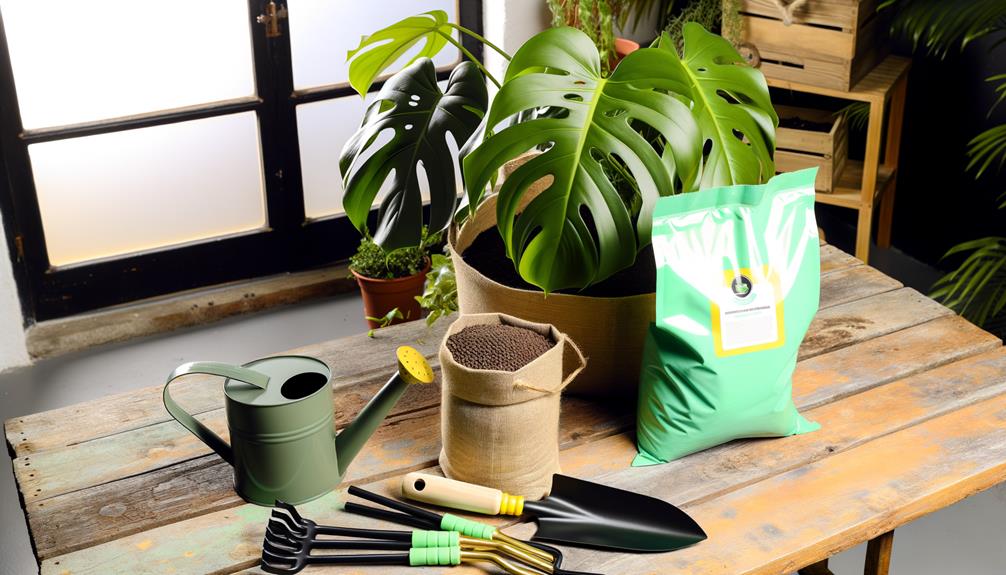Monstera Lechleriana Fertilizing Tips
To fertilize your Monstera Lechleriana, use a balanced, water-soluble fertilizer with a 20-20-20 N-P-K ratio every 4-6 weeks during spring to early autumn. Nitrogen aids leaf development, phosphorus supports roots and flowering, while potassium enhances structure and disease resistance.
Organic fertilizers improve soil health, though synthetic ones offer precise nutrient availability. Avoid fertilizing in winter, and watch for signs of over-fertilization like leaf burn or root damage.
Adjust accordingly if symptoms appear. Regularly monitor leaf color and growth to gauge the plant's nutrient needs.
To optimize growth through all seasons, there's much more to take into account.

Key Takeaways
- Use a balanced, water-soluble fertilizer with a 20-20-20 N-P-K ratio every 4-6 weeks during active growth.
- Fertilize during the active growing season from spring to early autumn; avoid winter dormancy feeding.
- Choose organic fertilizers for soil health or synthetic options for immediate nutrient availability.
- Monitor for leaf burn and salt crust on the soil to avoid over-fertilization; flush soil if necessary.
- Adjust fertilization frequency based on plant health and growth rate, reducing to every 8-10 weeks in winter.
Understanding Nutrient Needs
Understanding the nutrient needs of Monstera Lechleriana involves recognizing the essential elements like nitrogen, phosphorus, and potassium that are vital for its growth and overall health.
Nitrogen plays a significant role in leaf development and photosynthesis. You'll notice lush, green foliage when nitrogen levels are sufficient.
Phosphorus is important for root development and flowering. It aids in energy transfer within the plant.
Potassium strengthens the plant's overall structure and enhances its resistance to diseases.
To optimize your Monstera Lechleriana thrives, you should also monitor for secondary nutrients like calcium, magnesium, and sulfur, which support various physiological processes.
Regularly check the soil's nutrient profile and adjust as needed to prevent deficiencies and promote best growth.
Choosing the Right Fertilizer
To maximize your Monstera Lechleriana's thriving, you must carefully select a fertilizer that provides a balanced blend of essential nutrients. Consider the pros and cons of organic versus synthetic options while adhering to recommended application frequencies.
This approach will help you maintain peak plant health and growth.
Nutrient Balance Importance
Choosing the appropriate fertilizer for Monstera Lechleriana depends on achieving a balanced nutrient profile tailored to its specific growth requirements. You need to select a fertilizer that provides essential macronutrients: nitrogen (N), phosphorus (P), and potassium (K), often indicated by an N-P-K ratio. Nitrogen encourages leafy growth, phosphorus assists in root development, and potassium improves overall plant health.
In addition, micronutrients like iron, magnesium, and calcium play crucial roles in sustaining vibrant foliage and preventing deficiencies. Regularly check your plant for signs of nutrient imbalance, such as yellowing leaves or stunted growth, and adjust the fertilization schedule accordingly.
Organic Vs. Synthetic
When choosing between organic and synthetic fertilizers for your Monstera Lechleriana, consider how each type influences nutrient availability and long-term soil health.
Organic fertilizers, derived from natural sources, release nutrients slowly, fostering microbial activity and improving soil structure.
Synthetic fertilizers, chemically formulated, offer immediate nutrient availability but can lead to salt buildup and potential soil degradation over time.
Here's a breakdown to help you decide:
- Organic Fertilizers:
- Pros: Enhances soil health, reduces chemical runoff.
- Cons: Slower nutrient release, may require more frequent application.
- Synthetic Fertilizers:
- Pros: Immediate nutrient availability, precise nutrient ratios.
- Cons: Potential for soil degradation, risk of over-fertilization.
Choose based on your Monstera's needs and your long-term soil health goals.
Application Frequency Guidelines
Consistently applying the appropriate fertilizer is crucial for guaranteeing your Monstera Lechleriana receives the necessary nutrients for best growth and health.
For prime results, use a balanced liquid fertilizer with an N-P-K ratio of 20-20-20. During the growing season, from spring to early autumn, apply the fertilizer biweekly. Make sure the soil is moist prior to application to prevent root burn.
In the dormant winter months, reduce fertilization to once monthly, as the plant's metabolic activity decreases. Always dilute the fertilizer to half the recommended strength to avoid nutrient overload.
Monitoring the plant's response to fertilization will help you adjust the frequency and concentration, ensuring a healthy, thriving Monstera Lechleriana throughout the year.
Organic Vs. Synthetic Options
Choosing between organic and synthetic fertilizers for your Monstera Lechleriana involves understanding their distinct chemical compositions and effects on soil health and plant growth.
Organic fertilizers, derived from natural sources, release nutrients slowly and improve soil structure.
Conversely, synthetic options provide immediate nutrient availability but may lead to salt buildup and soil degradation over time.
Here's a quick comparison:
- Nutrient Release: Organic fertilizers offer slow, steady nutrient release; synthetic fertilizers provide rapid, immediate availability.
- Soil Health: Organic inputs enhance microbial activity and soil structure; synthetic ones can harm soil biota.
- Environmental Impact: Organics are eco-friendly and sustainable; synthetics may contribute to runoff and pollution.
- Application Ease: Synthetics are easier to apply with precise nutrient ratios; organics require more careful handling.
Choose based on your plant's needs and environmental considerations.
Best Time to Fertilize
For best growth and health, fertilize your Monstera Lechleriana during its active growing season, typically from spring through early autumn. This period aligns with the plant's natural growth cycle, ensuring it can fully utilize the nutrients. Here's a table to help visualize:
| Season | Growth Phase |
|---|---|
| Spring | Active Growth |
| Summer | Peak Growth |
| Early Autumn | Sustained Growth |
| Late Autumn | Slowed Growth |
| Winter | Dormancy |
During these months, the plant's metabolic activities are heightened, making it more receptive to nutrient uptake. Avoid fertilizing during winter when the plant enters dormancy; excess nutrients can lead to root burn or nutrient imbalances. By timing your fertilization correctly, you'll support robust growth and vibrant foliage.
Frequency of Feeding
To maintain peak health, you should fertilize your Monstera Lechleriana every 4-6 weeks during its active growing season. Consistent feeding promotes efficient nutrient uptake, encouraging robust growth and lush foliage.
Here's a practical guide to help:
- Early Spring to Late Summer: This is the active growing season. Fertilize regularly within this period.
- Dormant Phase: Reduce feeding frequency during fall and winter as the plant's growth slows.
- Balanced Fertilizer: Use a balanced, water-soluble fertilizer with a 20-20-20 N-P-K ratio for thorough nutrient coverage.
- Monitor Plant Response: Adjust frequency based on your plant's health. Signs of over-fertilization include yellowing leaves and nutrient burn.
Following these guidelines promotes your Monstera Lechleriana thrives year-round.
How to Apply Fertilizer
When applying fertilizer to your Monstera Lechleriana, you should choose a balanced, water-soluble fertilizer to maximize nutrient absorption.
Apply the fertilizer during the plant's active growth periods in spring and summer for the best results.
Always follow the manufacturer's instructions for dilution rates to prevent root burn and nutrient imbalances.
Choosing the Right Fertilizer
Selecting the ideal fertilizer for your Monstera Lechleriana involves understanding its specific nutrient needs and growth stages. This plant thrives with a balanced fertilizer that provides essential macronutrients: nitrogen (N), phosphorus (P), and potassium (K).
Here's how you can choose the right fertilizer:
- NPK Ratio: Opt for a balanced 20-20-20 or a 10-10-10 NPK ratio. These ratios guarantee your plant receives equal parts of nitrogen, phosphorus, and potassium.
- Formulation: Liquid fertilizers are preferable for even distribution and quick nutrient uptake.
- Organic vs. Synthetic: Organic fertilizers improve soil health but release nutrients slower. Synthetic fertilizers provide immediate nutrient availability.
- Micronutrients: Guarantee the fertilizer includes essential micronutrients like iron, magnesium, and zinc for thorough nourishment.
Optimal Application Timing
Applying fertilizer at the right time is crucial for ensuring your Monstera Lechleriana absorbs nutrients efficiently and grows healthily.
During the active growth phase, typically from spring to early fall, you should feed your plant every 4-6 weeks. Use a balanced, water-soluble fertilizer at half-strength to avoid nutrient burn.
In the dormant winter months, reduce fertilization to every 8-10 weeks, as the plant's metabolic processes slow down. Always water the plant thoroughly before applying fertilizer to prevent root burn.
Monitor the plant's response; yellowing leaves may indicate over-fertilization, while slow growth can signal nutrient deficiency. Adjust your schedule based on these cues, ensuring best nutrient uptake and robust development.
Signs of Over-Fertilizing
Excessive fertilizing of Monstera Lechleriana often leads to yellowing leaves, stunted growth, and a buildup of salts in the soil. Identifying over-fertilization is essential to maintaining your plant's health. Here are the key signs:
- Leaf Burn: Tips and edges of leaves turn brown and crispy due to high salt concentration.
- Root Damage: Roots appear blackened or mushy, hindering nutrient uptake.
- Salt Crust: A white, crusty layer forms on the soil surface, indicating salt accumulation.
- Reduced Growth: New leaves may emerge smaller and deformed.
To mitigate these issues, flush the soil with water to remove excess salts and reduce fertilizing frequency. Always follow recommended fertilizer dosages to avoid these adverse effects.
Seasonal Adjustments
Seasonal adjustments in fertilizing Monstera Lechleriana are vital for guaranteeing ideal growth and health throughout the year. During the growing season (spring and summer), you should apply a balanced, water-soluble fertilizer every two weeks. In the dormant period (fall and winter), reduce the frequency to once a month to prevent nutrient overload.
| Season | Frequency | Type of Fertilizer |
|---|---|---|
| Spring | Every 2 weeks | Balanced, water-soluble |
| Summer | Every 2 weeks | Balanced, water-soluble |
| Fall | Once a month | Diluted, balanced |
| Winter | Once a month | Diluted, balanced |
Adjusting the fertilizing schedule according to the seasonal growth cycle helps optimize nutrient uptake and promotes robust development. By doing so, you secure your Monstera Lechleriana thrives year-round.
Monitoring Plant Health
Regularly adjusting your fertilizing routine is just one part of ensuring your Monstera Lechleriana remains healthy; consistently monitoring plant health allows you to catch early signs of nutrient deficiencies or other issues.
To effectively monitor plant health, follow these steps:
- Leaf Color: Observe for yellowing or darkening leaves, indicating possible nutrient imbalances.
- Growth Rate: Track new leaf production; slow growth can signal fertilization issues or root problems.
- Leaf Texture: Feel for crispness or wilting, which may suggest over-fertilization or insufficient watering.
- Root Health: Inspect roots during repotting for rot or unusual coloration, signifying potential overwatering or poor soil conditions.
Conclusion
To keep your Monstera lechleriana thriving, think of fertilizing like giving it a balanced diet. Choose the right fertilizer, whether organic or synthetic, and apply it at the best times.
Feed your plant regularly, but avoid over-fertilizing by watching for signs. Adjust your routine seasonally and always monitor your plant's health.
With these tips, you'll optimize your Monstera grows lush and healthy, just as you'd nurture a prized specimen in a botanical garden.






